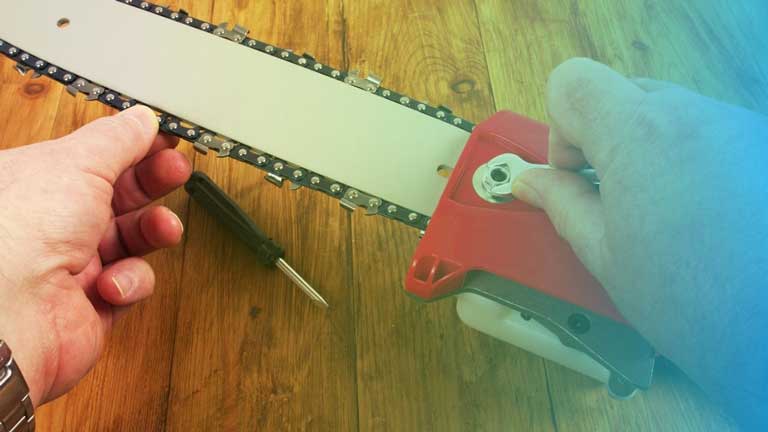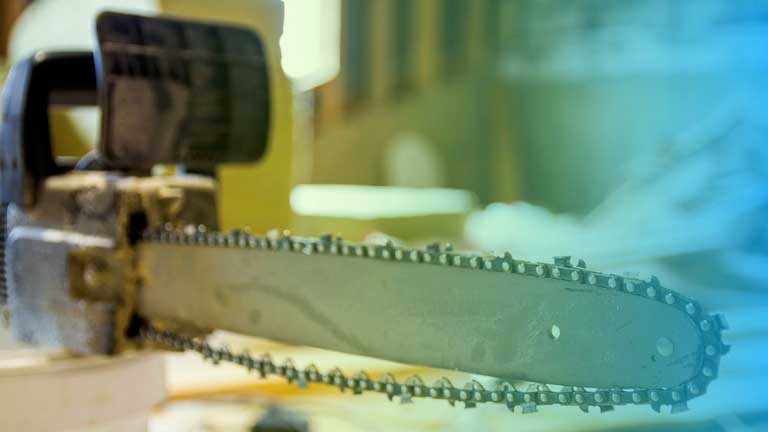Has your old chainsaw bar worn out or stopped working properly? If that is the case, then it just may be the time to replace your chainsaw bar with a new one. Seems obvious, right?
Here provide you information that will help you know the correct time and a method to replace the chainsaw bar without any hassle.
A chainsaw is a handy tool for carpenters, but it undergoes tough situations like cutting, spinning, and bearing heat due to heavy objects. And eventually, it starts losing its strength; however, being tough metals, most of the time, we don’t know when we should replace a chainsaw bar? However, the main reason to change it is due to the safety purpose.
When To Replace Chainsaw Bar?
To provide you more help, let’s have a glance at five signs that will help you to know the exact time to replace your chainsaw bar.

Sign 1: Wearing of Side Bars
The rails’ top sides are meant to be damaged more likely than the other parts and need a detailed visual inspection. The damage can be caused by hard cutting and bending of heavy objects during the process. The objects’ weight puts more pressure on one side of the rail rather than the other one.
Well, you can also identify this sign once you notice your chain won’t fit the rails or you feel the chunks are missing from the top. However, you can grind the top rail for a quick solution. But, if you think that a temporary solution won’t work for you, change your bar.
Sign 2: Twisted Chainsaw Bars
Well, the twisting bar can be a common situation for any chainsaw bar user. A heavy load may lead to twisted bars. You can inspect this by noticing both sides of the bar. One side is bent more than the other. Fortunately, this sign does not require a proper replacement at once. You can hit the bent area and fix it for temporary use.
Do remember that a damaged chainsaw can be a red alert for safety while working. If you find the bar is bent too much, replace it for a better working experience with your best gear. However, some people also look for repairing the damage, which is not exactly recommended. The repairing price could cost you more than the price of a good quality bar. So, why spend more when you have an option to save?
Sign 3: The Widen Grooves
Ever notice your chain wiggling side by the side of the bars. Well, the major reason behind the sign can be widened grooves than a regular gap. The wide spaces between the tracks result in loose or wiggling chains and make the chainsaw hard to work with. However, the loose chain can be a higher risk to workers, and it needs instant replacement.
The bar machine would save you in the situation for temporary solutions. Also, you can repair your chain through a shop. But, the best and recommended option is to replace it. However, the replacement would help you better handle and longer time to work stress-free with your chainsaw.
Sign 4: Jammed Sprocket or Damaged Sprocket
If you have a sprocket tip chainsaw bar, then sprocket is the part to show a worn-out effect earlier than any other details. However, the sign has a pretty simple reason which is insufficient oil in the component. Not only this, the sprocket can be worn out or damage because of the weight of the tree. As a result, a small part of the sprocket broke, leaving it jammed or damaged.
The nose sprocket allows the chains to move around the tip and makes the chainsaw speedy while increasing the power. In some cases, you can replace the sprocket nose. However, some may require a whole bar replaced.
Sign 5: Pinched Rails
The narrow area on the rail can be the reason for your chainsaw’s irregular working. The pinched rail decrease the room for smooth working. Moreover, they bear the heat, and you can notice spots over the bar. The pinched bar can be repaired easily and does not cause a risky situation any time soon.
If you got your rail repaired, test it by moving your chain. If you find the chain moving easily, you may need to replace the bar properly.
So, these were some of the signs to look for once when you think of replacing a bar of chainsaw. In addition to it, below is the stepwise guide to help you replace the bar by yourself without spending a penny.
How To Replace Chainsaw Bar?
Once you have identified any of the signs mentioned above and looking for a solution, then the next step is to replace it by yourself. Well, the process is pretty simple in most of the chainsaw. Remember that you should choose the bar of the exact length and size of the one you are replacing. So, lets’ have a look!

Step 1: Ensure Safety
Safety comes first. You should wear heavy-duty gloves before starting the process. Also, make sure to face the bar away from you. Additionally, if you have an electric-based chainsaw, you should switch off the kill switch. Or, if the chainsaw is gas-powered, ensure to disconnect the spark plug.
Step 2: Removing the Cover
Remove the cover from the bar and undo nuts to remove the sprocket or clutch cover. You can undo the nuts with the help of a 13mm socket but, it also depends upon the type of sprocket require or the kind of chain saw you have.
Step 3: Release Chain Tension
Once you are done with the cover removed, set it aside. Now push the bar backward to release the tension from the chain. Lose the chain by sliding the bar off through the adjustment points. You can clean the areas of the sprocket and cover it in this step.
Step 4: Install the New Chainsaw Bar
Now, slide the new bar into the adjustment posts and install it correctly. While doing this, make sure to face the sharp end of the chain’s blade point towards the bar’s front end. Do not forget to adjust the chain accurately in the grooves and rails.
Step 5: Tension the Chain
Once you have adjusted the chain, pull it forward to create tension in the chain. Insert the nuts and tighten the chain with the maximum tightness. Also, you can tighten it through the adjustment screws located in your adjustment posts.
Step 6: Put Everything in Place
After that, tighten the nuts of the sprocket cover and ensure everything is placed correctly in its right position. Do not overpressure the chain because it could be a reason for the chain’s damage.
Here, you are done with the process of replacing the bar of your chainsaw. Once you feel everything is in place, you can switch it on to check whether the process is done well or not. However, do not forget to take safety instructions once you are satisfied.
Things to Note while Replacing the Chainsaw Bar
Here are some of the important and helpful tips you need to look at before and while working with the chainsaw’s replacing process.
- Choose the correct size of the bar so that it can be handy for you to replace it.
- Disconnect the plug or switch it off before handling the process.
- Do not overtight the chain as it will wear out quickly.
- Tighten the chain till the driver comes out when you push it to the bottom.
- Ensure that nuts of sprockets are not tightened while tightening the chain.
- Use good quality oil to lubricate the components of the chainsaw.
- It is necessary to keep the grooves of the chainsaw clean from sawdust; otherwise, it will suck the oil.
- Oiler holes on each side of the bar must be clean.
- Use any flat thing to clear the dust from the small areas for the bar’s smooth working.
- To grease the new bar on the chainsaw, fill the oil reservoirs full.
- Also, you can lubricate the sprocket of the brand new bar on the chainsaw.
- You can use an oil hole for the nose sprocket to lubricate the area more properly.
- For more effective results, apply the oil with the cloth’s help on the chain to grease it.
- Insert the plug once everything is fine and snug.
How Long Does a Chainsaw Bar Last?
Well, without a bar, the chainsaw is just useless. Also, most of the time, a question may arise how long your bar would last? So, it is said by the specialists that a chainsaw bar can last up to eight years until or unless it experiences any sign of replacement. The signs can be bending, damaging or any of the ones mentioned above.
Moreover, the life of the bar depends upon the hours and type of use. The more you use the chainsaw, the shorten will be the life of your bar.
Conclusion
While concluding, it is equally important to look after the chainsaw’s bar as it is one of the parts that undergo tough situations. You have to identify the sign to know the correct time to replace your chainsaw bar. Also, you can avoid early worn-outs by keeping your chainsaw clean by removing any debris or sawdust in the grooves or small places. This practice will give your chainsaw bar a long-lasting life.
Moreover, we have mentioned the stepwise guide to help you with the process and some tips to look at while replacing your bar. We hope this piece of information has served you a helping hand.
Read Also:
Leave a Reply